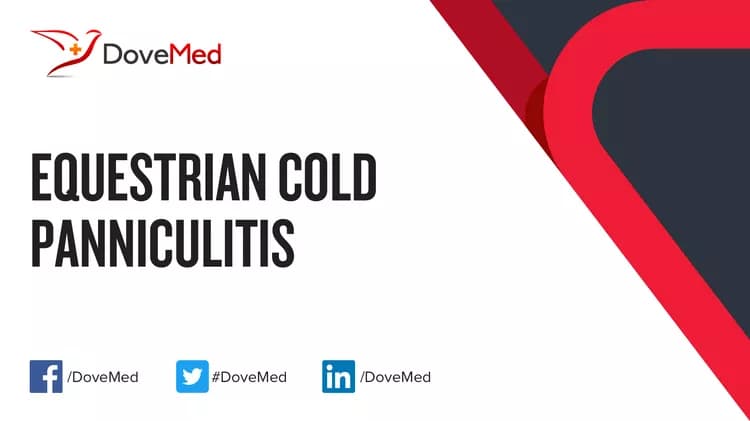What are the other Names for this Condition (Also known as/Synonyms)
- Cold Panniculitis from Horse-Riding
What is Equestrian Cold Panniculitis? (Definition/Background Information)
- Equestrian Cold Panniculitis is a unique but rare form of cold panniculitis that is observed in young women, who perform equestrian activities (horse-riding) wearing tightfitting attire that is usually non-insulated
- Cold panniculitis is an acute condition resulting in the inflammation of subcutaneous fat tissue just beneath the skin, on exposure to cold temperatures. The term ‘panniculitis’ indicates an inflammation of fat (adipose) tissue
- Equestrian Cold Panniculitis causes the formation of generally painless subcutaneous skin rashes and plaques at the site of cold exposure, which may be red in color. Usually, the thighs and buttocks are affected
- No severe symptoms or adverse complications have been reported from Cold Panniculitis. In many, the condition does not require any treatment and it gets better on its own. The prognosis of Equestrian Cold Panniculitis is typically excellent
Who gets Equestrian Cold Panniculitis? (Age and Sex Distribution)
- Equestrian Cold Panniculitis is a rare condition that is typically observed in younger women
- No racial or ethnic group predilection is observed and the condition is observed worldwide
What are the Risk Factors for Equestrian Cold Panniculitis? (Predisposing Factors)
The risk factors for Equestrian Cold Panniculitis include exposure to severe cold or injury from cold. This may occur from:
- Undertaking equestrian activities (horse-riding) in winter wearing tightfitting clothing that does not offer protection from cold
- Prolonged outdoor exercising of race horses during cold winters without wearing any protective clothing
It is important to note that having a risk factor does not mean that one will get the condition. A risk factor increases one’s chances of getting a condition compared to an individual without the risk factors. Some risk factors are more important than others.
Also, not having a risk factor does not mean that an individual will not get the condition. It is always important to discuss the effect of risk factors with your healthcare provider.
What are the Causes of Equestrian Cold Panniculitis? (Etiology)
- Equestrian Cold Panniculitis occurs specifically in young women following prolonged (several hours) exposure of skin to cold conditions during horse-riding activities
- It is reported that the subcutaneous fat crystalizes on exposure to cold temperatures resulting in inflammation
- The condition is aggravated by the use of non-insulated tightfitting riding attire in winter that restricts the free flow of blood beneath the skin
What are the Signs and Symptoms of Equestrian Cold Panniculitis?
The signs and symptoms of Equestrian Cold Panniculitis may include:
- The condition results in red rashes on skin that appears like a bruise. It may be accompanied by pain
- Localized thickening of skin may be noted with itchiness and burning sensation
- Many cases are reported involving the legs, thighs, buttocks, and even the lower abdomen region
- Cold panniculitis is mainly observed at the site of cold exposure. Any part of the body skin may be involved
How is Equestrian Cold Panniculitis Diagnosed?
Equestrian Cold Panniculitis may be diagnosed using the following tests and exams:
- Complete physical examination with comprehensive evaluation of medical history
- Assessment of the signs and symptoms
- Dermoscopy: It is a diagnostic tool where a dermatologist examines the skin using a special magnified lens
- Wood’s lamp examination: In this procedure, the healthcare provider examines the skin using ultraviolet light. It is performed to examine the change in skin pigmentation
- Skin or tissue biopsy, if necessary: A biopsy is performed and sent to a laboratory for a pathological examination. The pathologist examines the biopsy under a microscope. After putting together clinical findings, special studies on tissues (if needed) and with microscope findings, the pathologist arrives at a definitive diagnosis
- A differential diagnosis to exclude the following conditions may be necessary prior to a definitive diagnosis:
- Chilblains
- Frostbite
- Infectious cellulitis
- Post-steroid panniculitis
- Sclerema neonatorum
- Subcutaneous fat necrosis of the newborn
- Traumatic panniculitis
Many clinical conditions may have similar signs and symptoms. Your healthcare provider may perform additional tests to rule out other clinical conditions to arrive at a definitive diagnosis.
What are the possible Complications of Equestrian Cold Panniculitis?
In a majority of women, no significant complications due to Equestrian Cold Panniculitis are noted. However, in some rare cases, the following complications may be observed:
- Cosmetic issues that result in emotional stress
- Bleeding and ulceration of the skin may result in secondary viral or bacterial infections
- The rash can cause hyperpigmentation (increased skin pigmentation)
How is Equestrian Cold Panniculitis Treated?
In many individuals, no treatment is necessary for Equestrian Cold Panniculitis, since it is known to resolve spontaneously. If required, the following measures may be considered:
- Symptomatic and supportive therapy
- Gradually thawing the affected skin region can help in recovery
- Systemic steroid medications for severe cases
- Topical applications are generally not helpful
How can Equestrian Cold Panniculitis be Prevented?
Avoiding exposure to cold weather and cold temperatures while being unprotected can help prevent Equestrian Cold Panniculitis.
What is the Prognosis of Equestrian Cold Panniculitis? (Outcomes/Resolutions)
The prognosis of Equestrian Cold Panniculitis is typically excellent, since it is a self-limiting condition with no severe symptoms or complications being noted.
Additional and Relevant Useful Information for Equestrian Cold Panniculitis:
There are many different types of panniculitis and it has been difficult to obtain an accurate picture of their true incidence, since they may be associated with so many conditions. The different types may include:
- Lupus panniculitis
- Pancreatitis-associated panniculitis
- Alpha-1 antitrypsin deficiency associated panniculitis
- Infective panniculitis
Related Articles
Test Your Knowledge
Asked by users
Related Centers
Related Specialties
Related Physicians
Related Procedures
Related Resources
Join DoveHubs
and connect with fellow professionals



0 Comments
Please log in to post a comment.